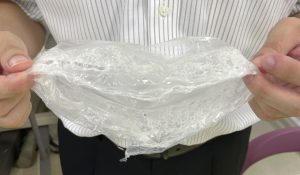Japanese scientists have found between 6.7 and 13.9 pieces of microplastic in each litre of cloud water tested.
Researchers in Japan have confirmed that microplastics are present in clouds, where they are likely affecting the climate in ways that are not yet fully understood.

In a study published in the journal Environmental Chemistry Letters, Japanese scientists climbed Mount Fuji and Mount Oyama in order to collect water from the mists that shroud the peaks, then applied advanced imaging techniques to the samples to determine their physical and chemical properties.
The team identified nine different types of polymers and one type of rubber in the airborne microplastics, which ranged in size from 7.1 to 94.6 micrometres.
Each litre (0.26 gallon) of cloud water tested contained between 6.7 to 13.9 pieces of the plastics.
“If the issue of ‘plastic air pollution’ is not addressed proactively, climate change and ecological risks may become a reality, causing irreversible and serious environmental damage in the future,” lead author of the research, Hiroshi Okochi of Waseda University, warned in a statement on Wednesday.
When microplastics reach the upper atmosphere and are exposed to ultraviolet radiation from sunlight, they degrade, contributing to greenhouse gasses, Okochi said.
Microplastics – which are defined as plastic particles under 5 millimetres that come from industrial effluent, textiles, synthetic car tires, personal care products and other sources – have already been discovered inside fish, peppering Arctic sea ice, and in the snows on the Pyrenees mountains between France and Spain.
However, the mechanisms of their transport to such varied locations had remained unclear, with research on airborne microplastic transport in particular being limited.
“To the best of our knowledge, this is the first report on airborne microplastics in cloud water,” the authors wrote in their paper.
Waseda University said in a statement on Wednesday that research shows that “microplastics are ingested or inhaled by humans and animals alike and have been detected in multiple organs such as lung, heart, blood, placenta, and faeces”.
“Ten million tons of these plastic bits end up in the ocean, released with the ocean spray, and find their way into the atmosphere. This implies that microplastics may have become an essential component of clouds, contaminating nearly everything we eat and drink via ‘plastic rainfall’”, the university said in announcing the new research findings.
Emerging evidence has linked microplastics to a range of effects on heart and lung health, as well as cancers, in addition to widespread environmental harm.








